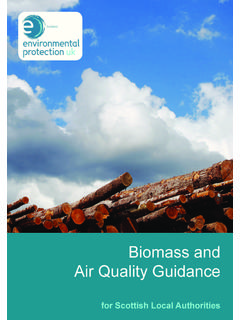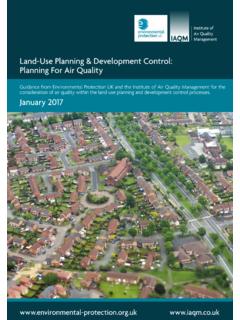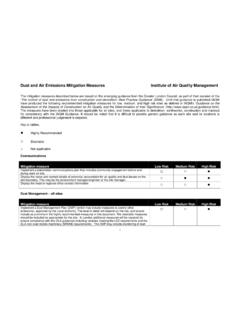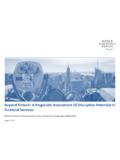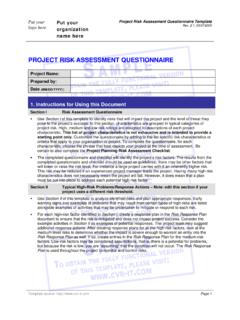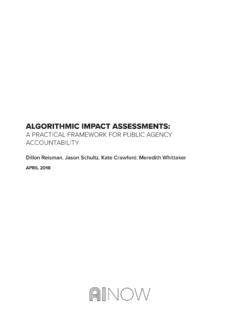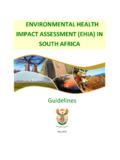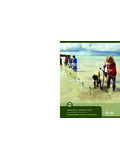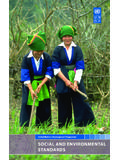Transcription of Guidance on the Assessment of Mineral Dust …
1 Institute ofAir Quality 1 15/01/2015 15:17 Guidance on the Assessment of Mineral dust Impacts for 2016 ( ) Contents 2 Acknowledgements 3 Foreword 41. Introduction & Scope 5 Introduction 5 Potential Impacts and Effects 5 The Need for this Guidance 6 Scope and Limitations 72. Standards, Guidance & Appeal Decisions 8 dust Standards and Guideline Values 8 Planning Policy Background 9 Planning Guidance on Minerals dust Assessments 9 Recent Appeal Decisions 103. Screen the Need for a Detailed Assessment 124. Recommended Content of a Minerals dust Assessment 145.
2 Assessing the dust Impacts & Effects of Minerals Developments 15 dust Deposition - General Approach 15 Suspended Particulate Matter - General Approach to Assessing the Health Effects 17 Conclusion on the Significance of Residual dust Effects 186. Factors Influencing the Risk Of dust Impacts 19 Categorising the Source, Pathway and Receptor Terms 19 Factors Influencing the Residual Source Emissions 19 Factors Influencing the Pathway 21 Receptors 227. Mitigation 258. Glossary & Terminology 29 Table 1 Summary of Limit Values and Objectives for Suspended Particulate Matter 8 Table 2 Estimation of dust impact Risk 16 Table 3 Descriptors for Magnitude of dust Effects 17 Table 4 Good Practice Mitigation Design Measures 26 Table 5 Basic Good Practice Mitigation Operational Measures 27 Figure 1: Site Assessment Flow Chart 11 Figure 2: Screening Flow Chart 13 Appendix 1: Recent Appeal Decisions 31 Appendix 2: PM10 concentrations Distance 33 Appendix 3: Example Procedure for a Disamenity dust Assessment 38 Appendix 4: Determining residual source emissions 42 Appendix 5: Sources of Information for PM10 Process Contributions 45 Appendix 6.
3 Recommended content of dust Management Plans (DMPs) for minerals 46planning applicationsContentsIAQM Guidance on the Assessment of Mineral dust Impacts for Planning 2 IAQM u Guidance Mineral DustAcknowledgementsThe Institute of Air Quality Management (IAQM) aims to be the authoritative voice for air quality by maintaining, enhancing and promoting the highest standards of working practices in the field and for the professional development of those who undertake this work. Membership of IAQM is mainly drawn from practicing air quality professionals working within the fields of air quality science, air quality Assessment and air quality management.
4 This Guidance has been produced as a result of the voluntary contribution of the members of a Working Group, for which IAQM is very grateful. This Guidance represents the views of the IAQM and not necessarily the individual members of the working group. Disclaimer: The information in this document is intended to provide Guidance for those undertaking dust assessments on Mineral sites and does not constitute legal IAQM has endeavoured to ensure that all information in this document is accurate. However, the organisation will not accept liability for any loss, damage or inconvenience arising as a consequence of any use of or the inability to use any information in this Guidance .
5 We are not responsible for any claims brought by third parties arising from your use of this Working Group members were: Dr Claire Holman (Chair), Brook Cottage Consultants Ltd Dr Hugh Datson, DustScan Ltd Mark Dawson, Wardell Armstrong LLP Rachel McHale, SLR Dr Jon Pullen, RPS Planning & Development Dr Srinivas Srimath, RSK Matt Stoaling, Isopleth Ltd Ian Stone, Advanced Environmental Penny Wilson, Air Quality ConsultantsA number of comments have been received from IAQM members on the draft of this Guidance . Many were very detailed and all were useful contributions that have helped clarify the Guidance . This document is available for download from the IAQM website ( ). Please go to IAQM Guidance .
6 Copyright statement: Copyright of these materials is held by the IAQM. We encourage the use of the materials but request that acknowledgement of the source is explicitly stated. All design rights are held by the IAQM, unless otherwise citation: IAQM (2016) Guidance on the Assessment of Mineral dust Impacts for Planning. Institute of Air Quality Management, : IAQM c/o Institution of Environmental Sciences 3rd Floor, 140 London Wall, London EC2Y 5DN T: +44 (0)20 7601 1920 E: Date: May 2016 Cover image: Hugh Datson, DustScan LtdGraphic design: Kate Saker (3 0/0 9/ 1 6) Table A3-2 - The criteria for infrequent changed from all days to dry days Appendix 4 B: Mineral Extraction - 3rd line under the graphic and/or low moisture content changed to and/or high moisture content.
7 Appendix 4 C: Materials Handling - 3rd line under graphic commas added after <5 plant and after site boundary .IAQM Guidance on the Assessment of Mineral dust Impacts for Planning 3 IAQM u Guidance Mineral DustForewordThe Institute of Air Quality Management (IAQM) is committed to enhancing the understanding and development of the science behind air quality by promoting knowledge and understanding of best working practices.
8 Membership of IAQM is mainly drawn from practising air quality professionals working within the fields of air quality science, air quality Assessment and air quality management. Air quality professionals are frequently required to assess dust impacts from Mineral sites, particularly as part of the planning process, and there is currently little government Guidance on how a dust Assessment should be undertaken. The National Planning Policy Framework (NPPF) replaced previous Guidance in 2012 as part of a process to reduce the volume of planning Guidance . New national Planning Practice Guidance (nPPG) for minerals was subsequently published online but provides little further detail.
9 Much of the information within the previous Guidance was useful and its replacement has created a vacuum. This IAQM document has been prepared to assist practitioners undertake such dust assessments for Mineral sites. It aims to provide advice on robust and consistent good-practice approaches that can be used to assess the operational-phase dust impacts. This Guidance is designed for use in the planning process; it is not designed for other purposes such as Environmental Permitting. This Guidance uses a simple distance-based screening process to identify those minerals sites where the dust impacts are unlikely to be significant and therefore require no further more detailed Assessment is required, a basic Assessment framework is presented which employs the Source Pathway Receptor approach to evaluate the risk of dust impacts and effects.
10 The predicted scale of dust effects may be classified as either significant , or not significant . Where effects are predicted to be significant , further mitigation is likely to be required before the proposals are considered to be acceptable under planning policy. The Assessment approach described here requires a degree of professional judgement from a competent and suitably experienced air quality professional in order to reach a conclusion on the overall significance of the effect. Full membership of the IAQM the only professional body specifically for air quality practitioners in the UK - can be evidence of such competence and experience.

